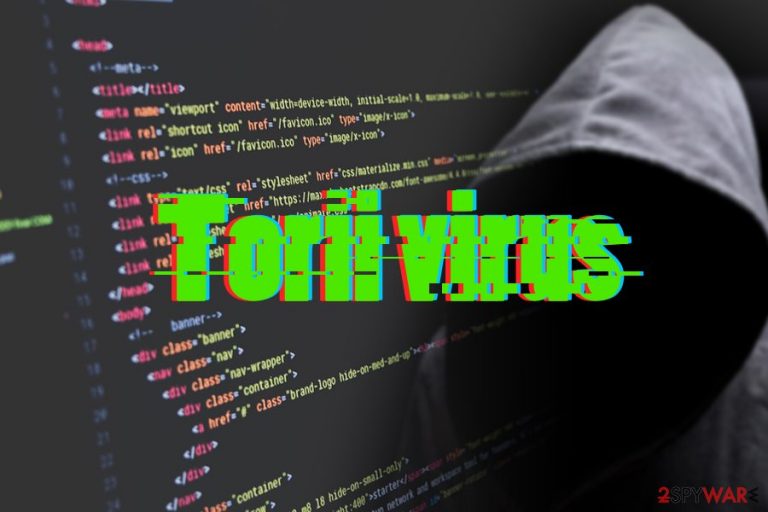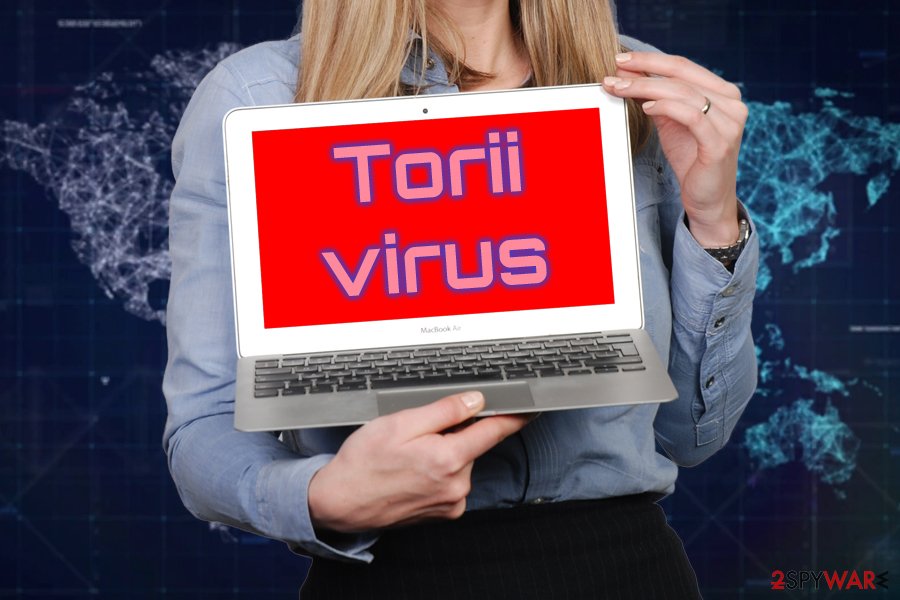Torii virus (Virus Removal Instructions) - Free Guide
Torii virus Removal Guide
What is Torii virus?
Torii virus – a sophisticated multi-stage malware that is capable of infecting a wide array of devices

Torii virus is a new malware strain that has been discovered by security experts in September 2018.[1] According to the report, this advanced cyber threat was functional since December 2017 and possibly even longer. The virus is capable of infecting a large variety of devices and functions as an IoT[2] botnet – it is able of propagating itself. Unlike botnets like Mirai or QBot, Torii botnet does not initiate active DDoS[3] attacks or crypto-mining but instead focuses on harvesting sensitive information. Once installed on the device, malware focuses on obfuscation by using multi-stage infection technique, downloading and executing other commands and continually communicating with the C2 server using encryption.
| Summary | |
| Name | Torii virus |
| Type | Botnet/malware |
| Distribution | Brute-force attacks |
| Spotted | September 2018 |
| Active since | December 2017 |
| Detection and elimination | Use sophisticated anti-malware software |
| System repair | Use FortectIntego |
Users might struggle to remove Torii virus since the malware is sophisticated. Moreover, detecting the cyber threat might be almost impossible unless the device is scanned with professional anti-malware software. We also suggest using FortectIntego to revert modifications performed by the virus.
Unlike banking trojan Emotet, Torii does not use malicious spam email attachments for its distribution. The infection starts when the virus breaks through weak Telnet credentials of the targeted device and uploads its primary script. At this point, the malware tries to identify the architectures used by the machine, which supports:
- x86
- x64
- ARM
- Motorola
- PPC
- SuperH
- MIPS
Then, Torii botnet virus focuses on downloading and installing appropriate binary payloads – all of the downloaded files are in ELF format. In case the HTTP connection is not successful, the virus uses an FTP protocol that requires authentication, which is embedded inside the script. As soon as the first stage is complete, the dropper will execute the downloaded ELF file to ensure persistence. The executable on itself runs six different processes to ensure that the malware is running all the time.
Once the inner ELF file is executed, the second stage payload actively communicates with the Command and Control server using the encrypted XOR cipher. Torii virus then sends the following information to a remote server:
- Hostname
- Process ID
- Path to second stage executable
- MAC address
- Device information, such as system name, version, release, etc.
- Executes several other commands to get more information about the device
It is not clear how many devices in total are affected by Torii virus, but researchers claim that one of the malware used IPs was connected to 1,056,393 times. However, experts believe that the server used is only one of many used servers infecting more devices worldwide.
Torii botnet virus is a sophisticated malware which researchers never encountered before. It sends out a large amount of information to the C2 server and is also capable of communicating with it continually, which allows bad actors to execute virtually any script on the affected device. Additionally, the obfuscation level of this malware is advanced. Thus, to remove Torii virus, users need to detect if first, which might be not an easy task.
It is yet unclear what goal this IoT malware has, as it is not used for DDoS or crypto-mining. Researchers think that it might be created to serve as a backdoor for other malware. Nevertheless, with its impressive persistence and obfuscation techniques, a simple factory reset on a device will not perform Torii virus removal.

Use strong passwords for all your devices
Botnets are dangerous because they can be used for various malicious activities, such as DDoS attacks or cryptocurrency mining on the device. Therefore, avoiding such infections is a far better solution, as security experts[4] suggest. As we know, the malware spreads using brute-force attacks via poorly protected devices. Therefore, we recommend you use a strong password and never leave your connection unprotected, as virus infection can be imminent.
There are several ways to protect your connection. For example, using a combination of upper and lower case letters and numbers would provide better protection. While it is hard to remember, such passwords should be handled by password managing programs.
Additionally, users are not recommended using the same password for multiple accounts because, as soon as one account gets compromised, hackers might use that information for further attacks.
Eliminate Torii from your device
Currently, thousands or even millions of devices are at risk of malware infection. Therefore, those who already are infected should take care of Torii virus removal as soon as possible. On itself, it might be a complicated task, as malware does not show any signs or symptoms. Besides, it uses several persistence techniques to remain running on the affected device.
The only way to remove Torii botnet virus is by using sophisticated anti-malware solutions. Because the botnet is recently established, and it is still under the investigation. Therefore, not all AV engines might detect the malicious payload. For that reason, it is advisable to scan your devices using multiple security applications.
Getting rid of Torii virus. Follow these steps
Manual removal using Safe Mode
To To remove Tori botnet effects on your machine, enter Safe Mode with Networking:
Important! →
Manual removal guide might be too complicated for regular computer users. It requires advanced IT knowledge to be performed correctly (if vital system files are removed or damaged, it might result in full Windows compromise), and it also might take hours to complete. Therefore, we highly advise using the automatic method provided above instead.
Step 1. Access Safe Mode with Networking
Manual malware removal should be best performed in the Safe Mode environment.
Windows 7 / Vista / XP
- Click Start > Shutdown > Restart > OK.
- When your computer becomes active, start pressing F8 button (if that does not work, try F2, F12, Del, etc. – it all depends on your motherboard model) multiple times until you see the Advanced Boot Options window.
- Select Safe Mode with Networking from the list.

Windows 10 / Windows 8
- Right-click on Start button and select Settings.

- Scroll down to pick Update & Security.

- On the left side of the window, pick Recovery.
- Now scroll down to find Advanced Startup section.
- Click Restart now.

- Select Troubleshoot.

- Go to Advanced options.

- Select Startup Settings.

- Press Restart.
- Now press 5 or click 5) Enable Safe Mode with Networking.

Step 2. Shut down suspicious processes
Windows Task Manager is a useful tool that shows all the processes running in the background. If malware is running a process, you need to shut it down:
- Press Ctrl + Shift + Esc on your keyboard to open Windows Task Manager.
- Click on More details.

- Scroll down to Background processes section, and look for anything suspicious.
- Right-click and select Open file location.

- Go back to the process, right-click and pick End Task.

- Delete the contents of the malicious folder.
Step 3. Check program Startup
- Press Ctrl + Shift + Esc on your keyboard to open Windows Task Manager.
- Go to Startup tab.
- Right-click on the suspicious program and pick Disable.

Step 4. Delete virus files
Malware-related files can be found in various places within your computer. Here are instructions that could help you find them:
- Type in Disk Cleanup in Windows search and press Enter.

- Select the drive you want to clean (C: is your main drive by default and is likely to be the one that has malicious files in).
- Scroll through the Files to delete list and select the following:
Temporary Internet Files
Downloads
Recycle Bin
Temporary files - Pick Clean up system files.

- You can also look for other malicious files hidden in the following folders (type these entries in Windows Search and press Enter):
%AppData%
%LocalAppData%
%ProgramData%
%WinDir%
After you are finished, reboot the PC in normal mode.
Remove Torii using System Restore
Alternatively, you can use System Restore to eliminate the virus:
-
Step 1: Reboot your computer to Safe Mode with Command Prompt
Windows 7 / Vista / XP- Click Start → Shutdown → Restart → OK.
- When your computer becomes active, start pressing F8 multiple times until you see the Advanced Boot Options window.
-
Select Command Prompt from the list

Windows 10 / Windows 8- Press the Power button at the Windows login screen. Now press and hold Shift, which is on your keyboard, and click Restart..
- Now select Troubleshoot → Advanced options → Startup Settings and finally press Restart.
-
Once your computer becomes active, select Enable Safe Mode with Command Prompt in Startup Settings window.

-
Step 2: Restore your system files and settings
-
Once the Command Prompt window shows up, enter cd restore and click Enter.

-
Now type rstrui.exe and press Enter again..

-
When a new window shows up, click Next and select your restore point that is prior the infiltration of Torii. After doing that, click Next.


-
Now click Yes to start system restore.

-
Once the Command Prompt window shows up, enter cd restore and click Enter.
Finally, you should always think about the protection of crypto-ransomwares. In order to protect your computer from Torii and other ransomwares, use a reputable anti-spyware, such as FortectIntego, SpyHunter 5Combo Cleaner or Malwarebytes
How to prevent from getting viruses
Access your website securely from any location
When you work on the domain, site, blog, or different project that requires constant management, content creation, or coding, you may need to connect to the server and content management service more often. The best solution for creating a tighter network could be a dedicated/fixed IP address.
If you make your IP address static and set to your device, you can connect to the CMS from any location and do not create any additional issues for the server or network manager that needs to monitor connections and activities. VPN software providers like Private Internet Access can help you with such settings and offer the option to control the online reputation and manage projects easily from any part of the world.
Recover files after data-affecting malware attacks
While much of the data can be accidentally deleted due to various reasons, malware is one of the main culprits that can cause loss of pictures, documents, videos, and other important files. More serious malware infections lead to significant data loss when your documents, system files, and images get encrypted. In particular, ransomware is is a type of malware that focuses on such functions, so your files become useless without an ability to access them.
Even though there is little to no possibility to recover after file-locking threats, some applications have features for data recovery in the system. In some cases, Data Recovery Pro can also help to recover at least some portion of your data after data-locking virus infection or general cyber infection.
- ^ Jakub Kroustek, Vladislav Iliushin, Anna Shirokova, Jan Neduchal and Martin Hron. Torii botnet - Not another Mirai variant. Avast blog. Malware research.
- ^ Internet of things. Wikipedia. The Free Encyclopedia.
- ^ Vangie Beal. DDoS attack - Distributed Denial of Service. Webopedia. Online Tech Dictionary.
- ^ LesVirus. LesVirus. Cybersecurity news and spyware articles.







